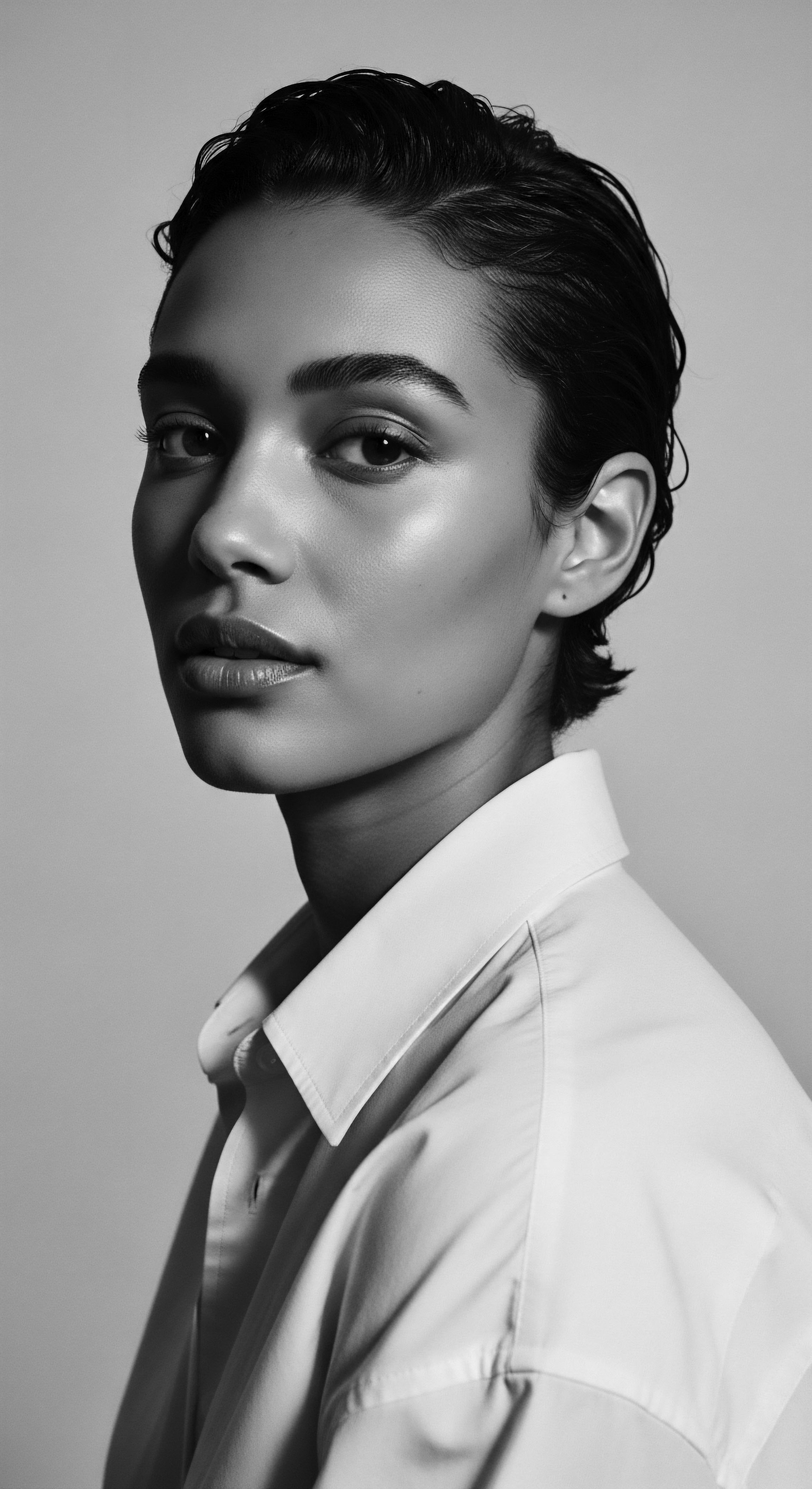
Fundamentals
The intricate world of textured hair begins its remarkable journey beneath the surface, within the very structures that sculpt each strand. At its foundational core, the concept of Follicle Differences refers to the unique anatomical variations inherent in the hair follicles themselves, variations that fundamentally dictate the distinct shape, curl pattern, and overall appearance of hair strands, particularly those of Black and mixed-race heritage. This initial delineation helps us grasp why some hair defies gravity in tight coils, while other strands flow in gentle waves, and still others present a rich tapestry of kinks and spirals.
Consider the hair follicle not simply as a tiny pore, but as a living root system, deeply anchored within the skin. Its shape, its orientation within the scalp, and the cellular processes unfolding within its depths are the primary architects of hair texture. A straight hair follicle, for instance, typically forms a circular cross-section, allowing the hair to emerge as a straight, cylindrical shaft.
However, in hair that manifests coils, curls, or kinks, the follicle exhibits a more elliptical or flattened cross-sectional shape. This distinct geometry means the hair strand itself grows with a corresponding oval or ribbon-like cross-section.
Moreover, the angle at which the follicle emerges from the scalp plays a significant role. Straight hair follicles often emerge at a near-perpendicular angle, allowing for a linear growth path. Yet, for textured hair, the follicle often grows at a more acute, sometimes even curved, angle beneath the skin before emerging.
This curved trajectory forces the hair shaft to twist and turn as it grows, generating the characteristic bends, loops, and zigzags we associate with diverse textured hair patterns. These foundational biological distinctions offer a powerful clarification regarding the inherent variability of hair across human populations.
Understanding these elemental Follicle Differences is not merely an exercise in biology; it is a step towards appreciating the inherent qualities of textured hair, recognizing its unique needs, and honoring the ancestral wisdom that often intuitively responded to these very characteristics long before microscopes revealed their presence. For generations, traditional hair keepers observed the varied behaviors of different hair patterns, developing care rituals that spoke to the hair’s propensity for dryness or its unique ways of tangling, practices that were, in essence, a response to the unseen whispers of the follicle’s design.
Follicle Differences, at their core, represent the fundamental anatomical variations in hair follicles that orchestrate the distinct shape, curl pattern, and overall texture of hair strands, particularly those of Black and mixed-race heritage.
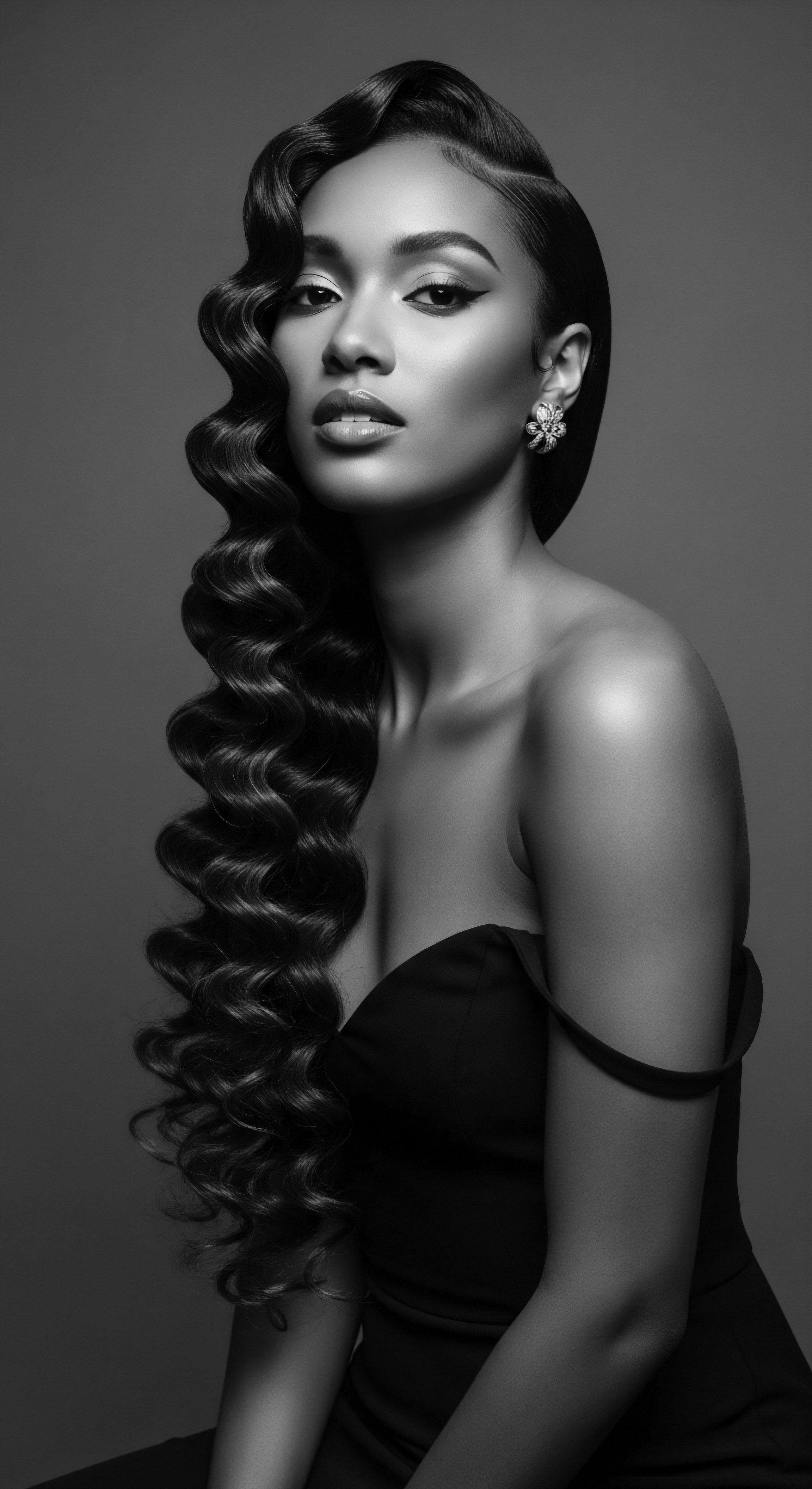
The Architects of Texture ❉ Follicle Shape and Growth Angle
The primary determinants of hair shape and curl pattern reside within the follicle’s very structure. A hair follicle, nestled within the dermis, begins its work deep within the skin.
- Follicle Shape ❉ The internal structure of the follicle largely dictates the cross-sectional shape of the hair shaft. A round follicle typically produces a circular hair strand, leading to straight hair. Conversely, an oval or flattened follicle yields an oval or ribbon-like hair shaft, which naturally encourages the strand to curve and coil as it grows. This is a primary mechanism behind curl formation.
- Follicle Angle ❉ The angle at which the follicle is set in the scalp influences the direction and path of hair growth. Follicles producing tightly coiled hair often emerge at a very sharp, almost parallel angle to the scalp, and sometimes even curve or twist beneath the skin before surfacing. This acute angle, coupled with the hair shaft’s elliptical shape, creates a highly intricate, often spiral, growth pattern.
These foundational anatomical details are the starting points for comprehending the vast spectrum of hair textures. The variations in follicle shape and angle mean that each hair strand possesses an individual growth trajectory, leading to a unique expression of its inherent genetic blueprint.
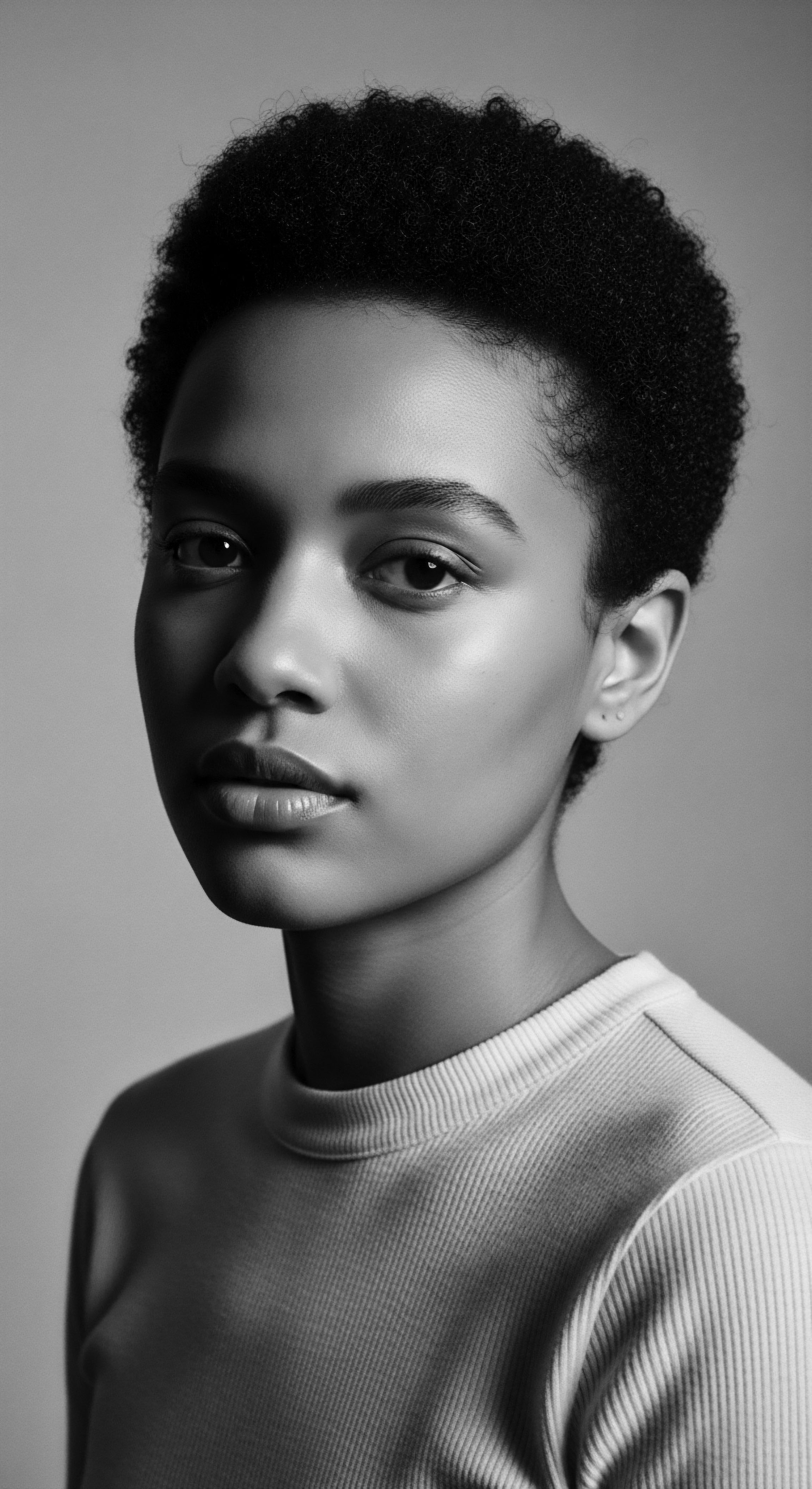
Intermediate
Delving deeper into the concept of Follicle Differences requires moving beyond basic anatomical shape to consider the complex interplay of cellular processes and the nuanced ways these manifest in textured hair. The explanation of Follicle Differences extends to the cellular activity within the dermal papilla—a small, cone-shaped structure at the base of the follicle that plays a crucial role in hair growth and differentiation—and the varied distribution of keratin proteins along the hair shaft. It is within these microscopic realms that the singular characteristics of coiled, curly, and kinky hair truly begin to unfold, shaping not only its physical appearance but also its unique moisture needs and inherent fragility.
The cross-sectional shape of the hair follicle, whether circular, oval, or flat, impacts the distribution and arrangement of keratin, the primary protein component of hair. In highly textured hair, where follicles are typically more elliptical or flat, the production and arrangement of keratin proteins can be unevenly distributed around the hair shaft’s circumference. This asymmetrical keratinization contributes to the hair strand’s tendency to curl and twist upon itself, creating a natural point of weakness at the bends and turns. Each bend, each coil, represents a place where the hair’s outermost layer, the cuticle, may be slightly raised or vulnerable, making it more susceptible to moisture loss and mechanical breakage.
Historically, ancestral hair practices developed an intuitive comprehension of these vulnerabilities. For instance, the meticulous act of cleansing and conditioning with natural botanicals, or the careful tension employed in braiding and twisting, were not random applications. These were sophisticated responses to the hair’s inherent structure, methods refined over generations to protect the cuticle, retain vital moisture, and mitigate breakage. The deep conditioning treatments, often involving rich plant oils and butters, served as emollients that helped to smooth the cuticle scales, providing a protective barrier against environmental aggressors and moisture evaporation.
Beyond shape, Follicle Differences encompass the cellular orchestration within the dermal papilla and the unique keratin distribution that renders textured hair vulnerable to moisture loss and breakage, guiding ancestral care traditions.

Follicle Morphology and Hair Health
The morphology, or form and structure, of the hair follicle profoundly influences the resultant hair shaft’s health and resilience.
- Asymmetrical Growth ❉ The flattened or elliptical follicle dictates an asymmetrical growth pattern of the hair shaft. This non-uniform growth causes the hair to twist and coil, creating natural stress points along its length. These structural vulnerabilities mean textured hair often requires particular care to maintain its integrity and prevent damage.
- Cuticle Integrity ❉ The tightly coiled nature of textured hair, stemming from its follicle’s design, means the hair’s cuticle—its protective outer layer composed of overlapping scales—is often raised at the points of curvature. This exposed cuticle allows moisture to escape more readily and makes the hair more prone to tangling and snagging.
- Moisture Retention ❉ The undulating path of textured hair also means that natural sebum, the scalp’s protective oil, struggles to travel down the entire length of the hair shaft. This, coupled with the raised cuticle, contributes to the characteristic dryness often experienced by individuals with textured hair, necessitating deliberate moisturizing practices.
These factors, stemming directly from the unique characteristics of hair follicles in textured hair, underscore the importance of tailored hair care. The ancestral emphasis on sealing moisture, gentle detangling, and protective styling emerges not as mere aesthetic preference, but as a practical, deeply informed response to the biological realities of the hair.
| Follicle-Driven Hair Characteristic Elliptical/Flat Follicle & Curved Growth |
| Ancestral Care Practice Braiding, Twisting, Locing, Cornrowing |
| Implied Understanding of Hair Need Protection from environmental stressors and breakage at stress points. |
| Follicle-Driven Hair Characteristic Raised Cuticle at Curves |
| Ancestral Care Practice Oiling scalp and hair with natural plant oils (e.g. Shea Butter, Coconut Oil) |
| Implied Understanding of Hair Need Sealing moisture, smoothing cuticle, reducing friction. |
| Follicle-Driven Hair Characteristic Difficulty for Sebum to Travel Down Shaft |
| Ancestral Care Practice Regular application of emollients and deep conditioning masques |
| Implied Understanding of Hair Need Replenishing moisture, compensating for natural dryness. |
| Follicle-Driven Hair Characteristic Increased Tendency to Tangle & Knot |
| Ancestral Care Practice Finger detangling, wide-tooth combs, gentle manipulation |
| Implied Understanding of Hair Need Minimizing mechanical damage and hair loss. |
| Follicle-Driven Hair Characteristic These ancestral practices, developed over millennia, illustrate a profound, embodied knowledge of hair's unique structure and needs stemming from Follicle Differences. |

Academic
The academic understanding of Follicle Differences transcends mere observation of shape and angle, delving into the sophisticated cellular mechanisms and genetic predispositions that orchestrate the profound variations in human hair texture, particularly as observed in individuals of African and mixed-race descent. This advanced inquiry recognizes that the architectural blueprint of the hair follicle—its cross-sectional geometry, its angle of insertion into the dermal layer, and crucially, the differential proliferation and migration of keratinocytes within the hair bulb—are not isolated phenomena but rather components of a highly regulated biological system. The precise definition of Follicle Differences, from an academic perspective, therefore encompasses the variability in the internal cellular dynamics and external morphological attributes of the hair follicle, which collectively determine the helical or curvilinear growth trajectory of the hair shaft, its unique mechanical properties, and its susceptibility to specific environmental and manipulative stresses.
Research indicates that the unique morphology of follicles producing highly textured hair is a product of genetic inheritance. For instance, studies have identified specific genes and single nucleotide polymorphisms (SNPs) associated with hair straightness, wave, and curl, suggesting a complex polygenic control over follicle shape and hair fiber curvature. The differential growth rates of cells on opposing sides of the follicle, or the uneven distribution of various keratin and keratin-associated proteins within the hair shaft, contribute significantly to the formation of coils and kinks.
Such asymmetry causes internal stresses that force the hair strand into a curled conformation. This scientific elucidation provides a rigorous backing to the observable diversity of hair textures, underscoring the biological basis for the unique needs of kinky, coily, and curly hair types.
The implications of these Follicle Differences are far-reaching, extending beyond biology into social and cultural domains, particularly within the Black diaspora. Historically, Western scientific and cultural narratives often marginalized or pathologized textured hair, interpreting its distinct characteristics through a lens of deficiency rather than biological diversity. This often led to the promotion of hair care practices and products that were ill-suited to the inherent structure of textured hair, frequently causing damage.
Yet, within African and diasporic communities, a rich corpus of ancestral hair knowledge persisted, developed through generations of lived experience and an intimate understanding of hair’s natural inclinations. This knowledge, though often uncodified by Western scientific metrics, provided effective methods for nurturing hair that respected its follicle-driven properties.
Academic understanding of Follicle Differences illuminates cellular dynamics and genetic predispositions orchestrating diverse hair textures, validating ancestral care while addressing historical misrepresentations.

Ancestral Acumen and Modern Validation ❉ A Case Study from the Himbe
One powerful illustration of this ancestral acumen can be found in the hair practices of the Himbe People of Namibia, a semi-nomadic group whose elaborate hair rituals serve as a living testament to an enduring, deeply applied understanding of hair structure and maintenance. Their hair, often described as reddish, thick dreadlocks, is meticulously crafted and maintained from childhood using a mixture of butterfat, ochre, and aromatic resins—a substance known as ‘otjize’. This ritual, far from being purely aesthetic, is a sophisticated response to the inherent characteristics of highly textured hair, directly addressing the vulnerabilities arising from its follicle structure.
The Himbe’s use of otjize, applied daily, acts as a profound sealant and protectant. From an academic perspective, the butterfat (a lipid-rich emollient) functions to lubricate the hair shaft, smoothing down the raised cuticle scales that are common at the bends of tightly coiled hair. This reduces friction, minimizes breakage, and helps retain the hair’s natural moisture, which otherwise evaporates rapidly from hair with an open cuticle and a challenging path for sebum distribution. The ochre, a mineral pigment, while providing the characteristic reddish hue, also acts as a natural sun protectant, guarding the hair against UV damage that can degrade keratin and further compromise the hair’s integrity.
The resins add a binding quality and antimicrobial properties. This intricate daily application, maintained over a lifetime, implicitly acknowledges the Follicle Differences that make Himbe hair susceptible to dryness and breakage without such consistent, protective intervention. The practice not only preserves hair health but also holds immense cultural, spiritual, and social significance, defining identity and status within the community.
The persistence and efficacy of practices like the Himbe’s stand in stark contrast to the historical imposition of Eurocentric beauty standards, which often led to damaging chemical treatments and heat styling that directly contradicted the biological needs of textured hair. While modern trichology now validates the principles of moisture retention, low manipulation, and protection for textured hair, these concepts have been embedded in ancestral practices for centuries. The Himbe provide a compelling historical example of how a deep, lived understanding of hair, implicitly acknowledging Follicle Differences, fostered practices that ensured the longevity and vitality of their hair, even in challenging environmental conditions, without the aid of microscopes or laboratories. This particular case highlights the profound intergenerational knowledge passed down, demonstrating an innate scientific literacy regarding the hair’s structural needs, a form of ethnobotany applied to trichology.

Genetic Underpinnings and Sociocultural Ramifications
The genetic basis of Follicle Differences is a rapidly expanding area of research. Specific genes, like those involved in keratin production or follicle morphogenesis, are being identified as contributing to the diverse array of hair textures. For instance, the EDAR gene, known for its role in hair thickness and straightness in East Asian populations, contrasts with genetic markers observed in populations of African descent, which are associated with the high curvature and elliptical cross-sections characteristic of coiled and kinky hair. This genetic predisposition means that the unique features of textured hair are not deviations from a norm, but rather distinct, evolutionarily adapted expressions of human diversity.
The sociocultural ramifications of Follicle Differences are equally profound. For centuries, the distinct visual qualities of textured hair have served as markers of identity, status, and community in many African societies. However, post-colonization and during periods of enslavement and diaspora, these very distinctions became targets of systemic discrimination.
Hair that naturally grew from follicles shaped for coils and kinks was often deemed “unprofessional” or “unruly” in Western contexts, leading to psychological distress, economic disadvantages, and forced assimilation practices within Black communities. The fight for natural hair acceptance, therefore, is not merely a trend; it is a profound movement to reclaim the inherent beauty and dignity of hair born from these specific Follicle Differences, a movement that seeks to dismantle centuries of imposed standards and embrace ancestral heritage.
Understanding the intricate science behind Follicle Differences provides an intellectual bedrock for appreciating the aesthetic and cultural richness of textured hair. It empowers individuals with the knowledge to care for their hair in ways that honor its biological reality, rather than forcing it into unnatural forms. This academic clarification of Follicle Differences ultimately supports the holistic well-being of individuals with textured hair, fostering a greater connection to their heritage and a deeper appreciation for the resilience of their ancestral strands. The long-term consequences of this informed perspective include better hair health outcomes, reduced discrimination, and a renewed sense of pride in diverse hair legacies, cultivating a future where hair is celebrated in all its magnificent forms.
| Era/Context Pre-Colonial African Societies |
| Impact of Follicle Differences on Perception/Practice Hair textures, stemming from varied follicle shapes, were integral to group identification, social status, and spiritual beliefs. |
| Sociocultural Significance / Response Elaborate, diverse styling (braids, twists, locs) reflected lineage, marital status, age, or readiness for war. Hair was a sacred connection to the divine and ancestors. |
| Era/Context Transatlantic Slave Trade & Enslavement |
| Impact of Follicle Differences on Perception/Practice Forced displacement and harsh conditions made traditional hair care impossible; European aesthetics deemed coiled/kinky hair "undesirable." |
| Sociocultural Significance / Response Hair became a site of resistance; clandestine practices for cleansing and styling sustained identity; head coverings protected hair and maintained dignity. |
| Era/Context Post-Emancipation to Civil Rights Era |
| Impact of Follicle Differences on Perception/Practice Pressure to assimilate led to chemical straightening (relaxers) and hot combing to conform to Western beauty standards, often causing damage to fragile hair. |
| Sociocultural Significance / Response "Good hair" vs. "bad hair" dichotomies emerged, reflecting internalized oppression; hair care industry catered to straightening; early activism slowly challenged these norms. |
| Era/Context Modern Natural Hair Movement (21st Century) |
| Impact of Follicle Differences on Perception/Practice Reclamation of natural textures, fueled by increased scientific understanding of Follicle Differences and self-acceptance. |
| Sociocultural Significance / Response Celebration of coils, kinks, and curls as inherent beauty; emergence of diverse, texture-specific products; legal protections against hair discrimination (e.g. CROWN Act). |
| Era/Context The journey of textured hair through history, intrinsically linked to Follicle Differences, mirrors the resilience and continuous redefinition of identity within Black and mixed-race communities. |
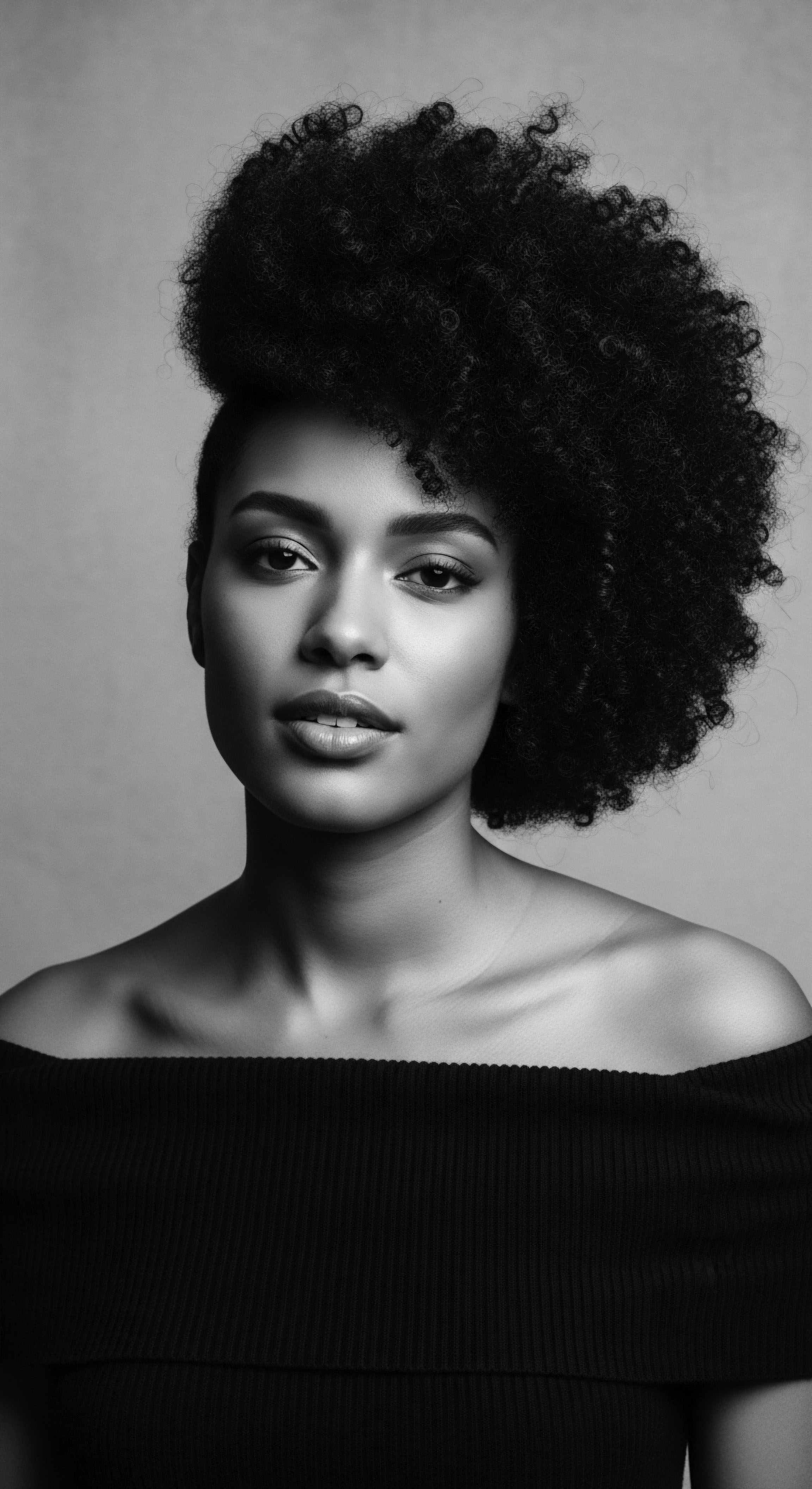
Reflection on the Heritage of Follicle Differences
As we gaze upon the intricate landscape of Follicle Differences, it becomes strikingly clear that our understanding extends far beyond the realm of scientific diagrams and biological classifications. It is a profound meditation on the journey of textured hair—a journey that is inextricably woven into the very fabric of human heritage, particularly for those whose roots stretch across the African diaspora. Each coil, each kink, each wave is a living archive, carrying within its structure the echoes of ancestral wisdom, the resilience of generations, and the boundless creativity born from both necessity and celebration. The precise biological distinctions of the follicle are not merely academic curiosities; they are the very threads that connect us to ancient practices of care, to the deep cultural significance of hair as a spiritual conduit, a marker of identity, and a canvas for artistry.
The story of Follicle Differences, seen through Roothea’s lens, is a story of enduring power and adaptation. It reminds us that long before the advent of microscopes, our ancestors possessed an intuitive, profound understanding of hair’s inherent needs, responding to its unique structure with ingenious methods that ensured its vitality and spiritual resonance. The deliberate oiling with shea butter in West Africa, the meticulous braiding in the Caribbean, or the protective styling across various Indigenous communities—these were not random acts, but precise applications of knowledge passed down through generations, directly addressing the characteristics stemming from specific follicle designs. This legacy affirms that hair care for textured hair is not a modern invention but a continuous, living tradition, rooted in an intimate conversation with the hair’s very being.
Moving forward, our heightened understanding of Follicle Differences should only deepen our reverence for this rich heritage. It invites us to honor the wisdom of those who came before us, to continue their practices, and to build upon their foundation with informed reverence. This appreciation fosters a deeper sense of self-acceptance and pride, allowing us to see our hair not as a challenge to be conquered, but as a beautiful, powerful expression of our ancestral lineage—a constant reminder of the strength and beauty that have persisted through time. The ongoing exploration of Follicle Differences, therefore, is not just about what is, but what has been, and what will continue to be, a testament to the unbound helix of our shared human story.
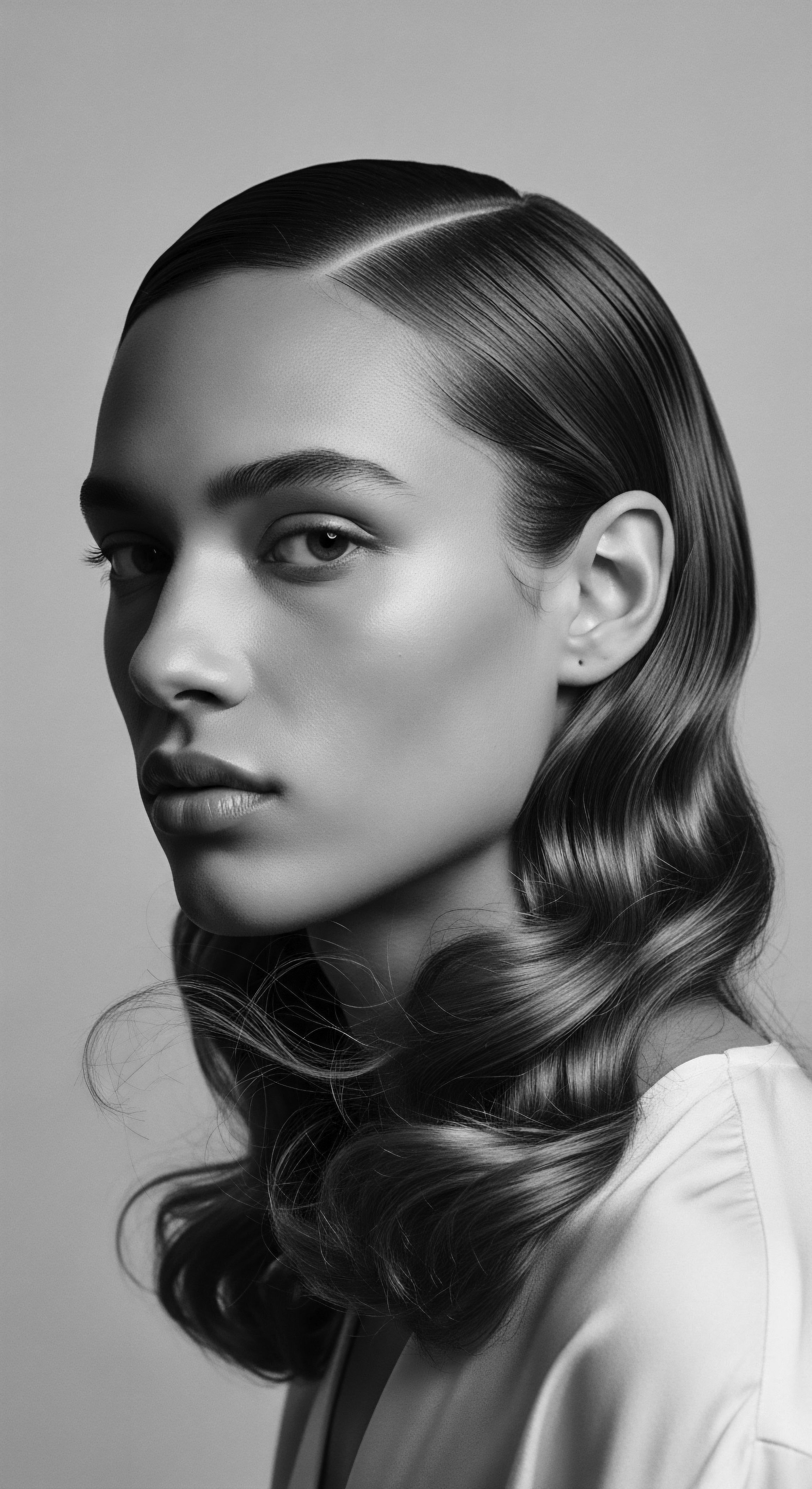
References
- Loussouarn, G. (2001). African hair morphology and its implications. In C. Bouillon & J. Wilkinson (Eds.), The Science of Hair Care (2nd ed. pp. 115-128). Taylor & Francis.
- Mohs, M. (2007). African Hair ❉ Culture, Beauty, and Struggle. Oxford University Press.
- Robbins, C. R. (2012). Chemical and Physical Behavior of Human Hair (5th ed.). Springer.
- Goodman, M. (2019). Hair Story ❉ Untangling the Roots of Black Hair in America. St. Martin’s Press.
- Gore, S. L. (2001). Hair as a cultural symbol ❉ An anthropological investigation of hair in Nigeria. Journal of Black Studies, 31(4), 515-539.
- Powell, K. (2013). The Social Politics of Black Hair ❉ From Natural Hair to the Weave. Race, Gender & Class, 20(1/2), 22-35.
- Rogers, G. E. (2006). Keratin, hair follicles and their disorders. Journal of Cosmetic Science, 57(4), 283-294.
- Speller, D. (2007). The Hair Commandments ❉ The Sista’s Guide to Healthy Hair. Sistah Power Productions.
- Thompson, S. (2018). Hair ❉ A Cultural History. Bloomsbury Academic.
- Walton, J. (2008). Black Hair ❉ Art, Culture, and History. Artmedia Publications.
